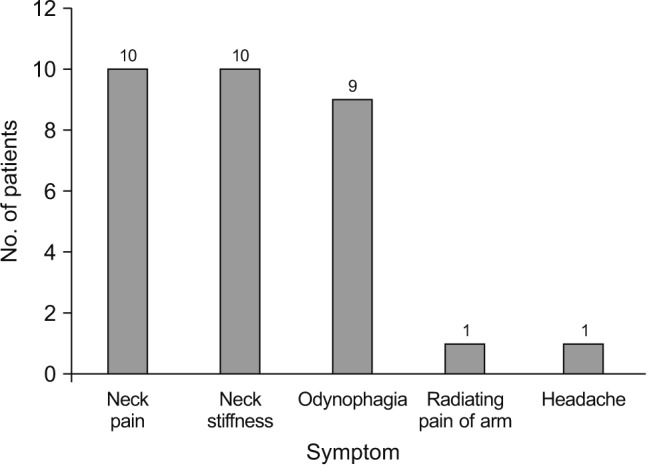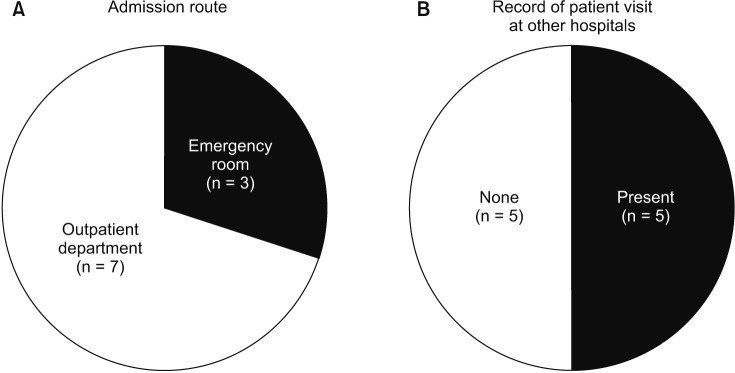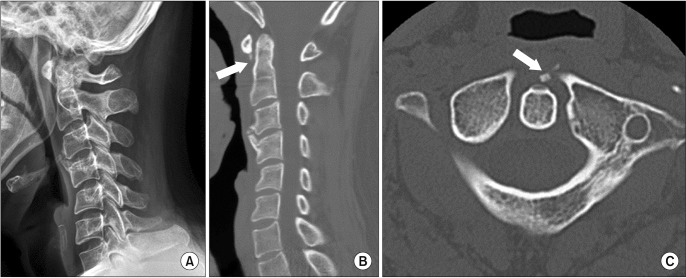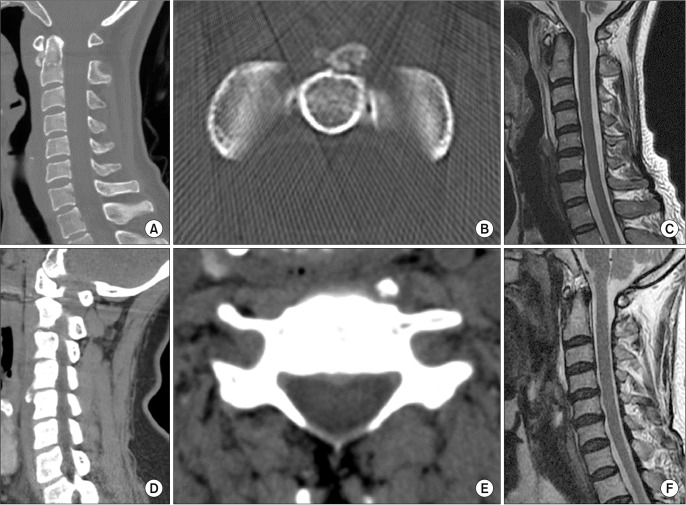Clin Orthop Surg.
2018 Jun;10(2):204-209. 10.4055/cios.2018.10.2.204.
Clinical and Imaging Features of Longus Colli Calcific Tendinitis: An Analysis of Ten Cases
- Affiliations
-
- 1Spine Center and Department of Orthopaedic Surgery, Pohang Semyeong Christianity Hospital, Pohang, Korea. shinji11911@gmail.com
- KMID: 2411746
- DOI: http://doi.org/10.4055/cios.2018.10.2.204
Abstract
- BACKGROUND
Longus colli calcific tendinitis (LCCT) exhibits characteristic clinical features; thus, misidentification can be avoided once it is learned. There is a lack of reports on this disease. In this study, we analyzed the imaging and clinical features of LCCT in 10 patients.
METHODS
We retrospectively reviewed the radiolographic findings, laboratory data and clinical features of 10 patients diagnosed with LCCT between January 2015 and June 2017. All patients were treated with medical treatment consisting of intravenous methylprednisolone 125 mg twice and oral nonsteroidal anti-inflammatory drug administration.
RESULTS
On clinical findings, all 10 patients complained of severe posterior neck pain and cervical motion limitation. Odynophagia was present in nine patients. The mean time from symptom onset to hospital visit was 2.9 days. The mean time to symptom relief was 4.6 days. Of the 10 patients, three patients were admitted through the emergency room. There were five patients in the medical records who were transferred from another hospital. On the laboratory data, the mean value of C-reactive protein and erythrocyte sedimentation rate were 2.08 mg/dL (reference range, < 0.30 mg/dL) and 36.9 mm/hr (reference range, < 20 mm/hr), respectively. Leukocytosis was found in only two patients and fever was not present all patients. On radiographic findings, calcification was present on computed tomography images of all patients. The calcification was located at the lower part of the C1 arch, except for one case where calcification occurred in the anterolateral aspect of the C4-5 disc space. The mean value of the retropharyngeal space was 7.2 mm.
CONCLUSIONS
LCCT, a rare disease, has characteristic radiographic findings and clinical features. Understanding such characteristics of this disease can prevent unnecessary testing and misdiagnosis.
MeSH Terms
Figure
Reference
-
1. Tagashira Y, Watanuki S. Acute calcific retropharyngeal tendonitis. CMAJ. 2015; 187(13):995. PMID: 25918175.
Article2. Shin DE, Ahn CS, Choi JP. The acute calcific prevertebral tendinitis: report of two cases. Asian Spine J. 2010; 4(2):123–127. PMID: 21165316.
Article3. Ring D, Vaccaro AR, Scuderi G, Pathria MN, Garfin SR. Acute calcific retropharyngeal tendinitis: clinical presentation and pathological characterization. J Bone Joint Surg Am. 1994; 76(11):1636–1642. PMID: 7962023.
Article4. Eastwood JD, Hudgins PA, Malone D. Retropharyngeal effusion in acute calcific prevertebral tendinitis: diagnosis with CT and MR imaging. AJNR Am J Neuroradiol. 1998; 19(9):1789–1792. PMID: 9802506.5. Boikov AS, Griffith B, Stemer M, Jain R. Acute calcific longus colli tendinitis: an unusual location and presentation. Arch Otolaryngol Head Neck Surg. 2012; 138(7):676–679. PMID: 22801892.6. Zibis AH, Giannis D, Malizos KN, Kitsioulis P, Arvanitis DL. Acute calcific tendinitis of the longus colli muscle: case report and review of the literature. Eur Spine J. 2013; 22(Suppl 3):S434–S438. PMID: 23179983.
Article7. Tezuka F, Sakai T, Miyagi R, et al. Complete resolution of a case of calcific tendinitis of the longus colli with conservative treatment. Asian Spine J. 2014; 8(5):675–679. PMID: 25346822.
Article8. Hartley J. Acute cervical pain associated with retropharyngeal calcium deposit: a case report. J Bone Joint Surg Am. 1964; 46:1753–1754. PMID: 14239862.9. Horowitz G, Ben-Ari O, Brenner A, Fliss DM, Wasserzug O. Incidence of retropharyngeal calcific tendinitis (longus colli tendinitis) in the general population. Otolaryngol Head Neck Surg. 2013; 148(6):955–958. PMID: 23525848.
Article10. Harnier S, Kuhn J, Harzheim A, Bewermeyer H, Limmroth V. Retropharyngeal tendinitis: a rare differential diagnosis of severe headaches and neck pain. Headache. 2008; 48(1):158–161. PMID: 17868355.
Article11. Park R, Halpert DE, Baer A, Kunar D, Holt PA. Retropharyngeal calcific tendinitis: case report and review of the literature. Semin Arthritis Rheum. 2010; 39(6):504–509. PMID: 19540570.
Article12. Joaquim AF, Appenzeller S. Cervical spine involvement in rheumatoid arthritis: a systematic review. Autoimmun Rev. 2014; 13(12):1195–1202. PMID: 25151973.13. Paimela L, Laasonen L, Kankaanpaa E, Leirisalo-Repo M. Progression of cervical spine changes in patients with early rheumatoid arthritis. J Rheumatol. 1997; 24(7):1280–1284. PMID: 9228125.
- Full Text Links
- Actions
-
Cited
- CITED
-
- Close
- Share
- Similar articles
-
- Acute Calcific Prevertebral Tendinitis without Differentiated by Simple X-ray
- Acute Longus Colli Tendinitis without Calcification
- Acute Calcific Tendinitis of the Longus Colli Muscle in the Cervical Spine
- The Acute Calcific Prevertebral Tendinitis: Report of Two Cases
- A Case of Retropharyngeal Calcific Tendinitis in a Patient with Ankylosing Spondylitis





